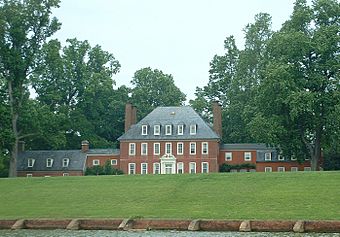Westover Plantation facts for kids
|
Westover Plantation
|
|

Westover from the front (river) side
|
|
| Location | 7 mi. W of Charles City on VA 5, Charles City County, Virginia, United States of America |
|---|---|
| Area | 1,025 acres (4.15 km2) |
| Built | c. 1750 |
| Architectural style | Georgian |
| NRHP reference No. | 66000923 |
Quick facts for kids Significant dates |
|
| Added to NRHP | October 15, 1966 |
| Designated NHL | October 9, 1960 |
Westover Plantation is a very old and important estate in Charles City County, Virginia. It sits right on the north bank of the James River. This historic place was built around 1730 to 1750. It was the main home for the famous Byrd family of Virginia.
A road called State Route 5 runs near the plantation. This road is known for its beautiful views. It connects the cities of Richmond and Williamsburg. Westover Plantation is recognized as a National Historic Landmark in the United States. It is special because of its amazing Georgian-style mansion and the history of the powerful Byrd family. In the early days of the Virginia colony, Westover was even a place where county courts were held.
Contents
A Look Back: Westover's Story
Early Days and Owners
The land that became Westover Plantation was first transferred in 1665. Sir John Pawlett sold most of it to Theodorick Bland of Westover. Bland lived there until he passed away in 1671. He was buried at the original Westover Church, which he helped build.
His oldest son, Theodorick, inherited the land. He later shared ownership with his brother, Richard. In 1688, the brothers sold 1,200 acres of the property. They sold it to William Byrd I for money and tobacco.
The Byrd Family Home
Westover is famous for its history from the 1700s onwards. The main house, Westover Plantation, was built in the Georgian style. It was considered the most important home of the William Byrd family in Virginia.
For a long time, people thought William Byrd II built the mansion around 1730. He was the person who founded the city of Richmond. This date was part of why the house was named a National Historic Landmark in 1960.
However, in recent years, scientists used a method called dendrochronology. This method studies tree rings in wood. They tested the wood in the house. The tests showed the wood dated to the 1750s. This means the house was likely built and first lived in by William Byrd III, not his father. The National Park Service now agrees with this new date.
Farming and Enslaved People
Like other large farms along the James River, Westover first grew tobacco. Tobacco was the main crop in colonial Virginia. The Byrd family relied on the hard work of hundreds of enslaved Africans. Growing tobacco needed many workers.
The original estate included living areas for enslaved people. Besides working in the fields, some enslaved people worked as house servants. Others were skilled workers, like carpenters or blacksmiths. Over time, tobacco farming wore out the soil. Farmers also started growing different crops. In the 1800s, they switched to mixed crops, which needed fewer workers.
Westover During the Civil War
During the American Civil War, Westover was used by the Union army. It served as the headquarters for their Fifth Corps. One part of the house was burned during this time.
After William Byrd III's wife passed away in 1814, Westover was sold. It was no longer owned by the Byrd family. Since then, Westover has had three more owners. One owner was John Armistead Selden, a lawyer. He kept detailed diaries about daily life at Westover. These diaries are still published and teach us a lot about farming and culture in Virginia during the 1800s.
Another owner was Augustus Harrison Drewry. He was an officer in the Confederate Army. He is known for leading the gun batteries at Fort Darling. This happened during the Battle of Drewry's Bluff in 1862. Drewry lived at Westover until he died in 1899. He made many changes to the house. He rebuilt the burned part and made the dining room larger.
Modern Times and Restoration
In the early 1900s, Richard Teller Crane, II bought Westover. He was a United States diplomat. He worked to restore the mansion and its beautiful gardens. The Crane family has owned Westover ever since.
In 2003, Hurricane Isabel caused some damage to the site. Ten feet of the riverbank washed away. A 250-year-old road and a 150-year-old tree were also lost to the river.
Westover's Amazing Architecture
The Westover house is famous for its perfect balance and design. It has secret passages and beautiful gardens. The front door is also very special. Its Georgian style was inspired by the Governor's Palace in Williamsburg, Virginia.
You can visit the grounds and garden every day from 9 a.m. to 6 p.m. If you want to tour the inside of the mansion, you need to make an appointment first.
Westover in Movies and TV
Westover Plantation has been featured in many popular shows and movies!
- The outside of Westover was used in the first episode of "The West Wing." It was the home of a made-up character named Leo McGarry.
- The plantation was a filming location for every season of AMC's show "Turn." This show was about the Revolutionary War and ran from 2014 to 2017.
- It was also seen in the HBO miniseries "John Adams" in 2008.
- Most recently, it appeared in the 2014 film "The Field of Lost Shoes."


